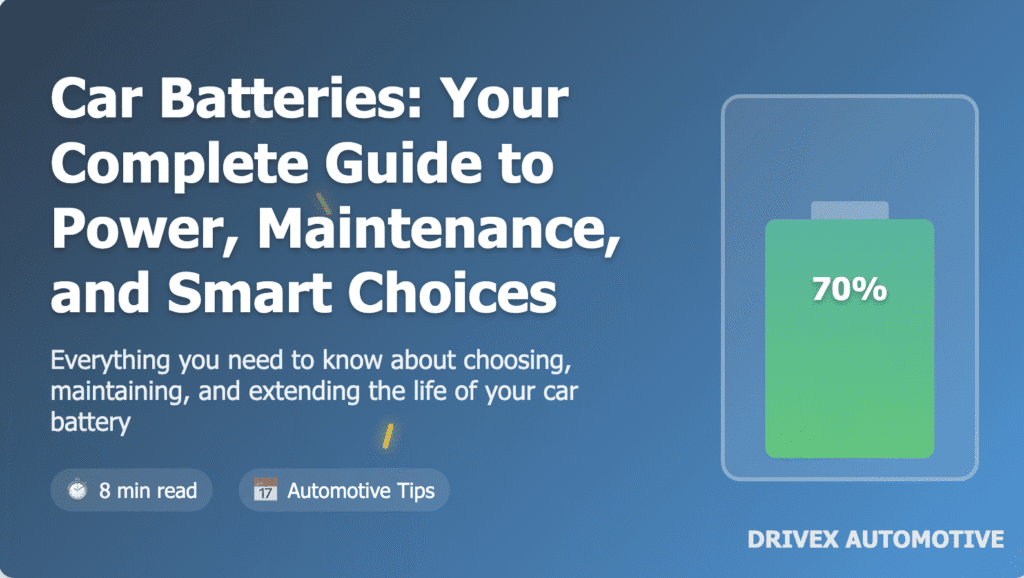
Posted on 26th September 2025 | 8 min read | Automotive Tips
When you turn the key in your ignition, you’re relying on one of the most crucial components in your vehicle: the car battery. This unsung hero provides the electrical spark that brings your engine to life and powers everything from your headlights to your infotainment system. Understanding your car battery can save you from unexpected breakdowns and help you make smarter purchasing decisions.
The Heart of Your Vehicle’s Electrical System
Your car battery serves three essential functions:
Starting Power: Delivers a burst of energy to start your engine
Stabilization: Acts as a voltage stabilizer for your electrical system
Backup Power: Provides electricity when demand exceeds the alternator’s output
Most drivers don’t think about their battery until it fails, but with proper knowledge, you can extend its life and avoid being stranded.
Types of Car Batteries: Which One Is Right for You?
- Lead-Acid Batteries (The Traditional Choice)
The most common and affordable option, lead-acid batteries have been powering vehicles for decades. They contain lead plates submerged in sulfuric acid electrolyte.
Pros:
Most affordable option
Widely available everywhere
Reliable performance in most conditions
Cons:
Requires regular maintenance (checking fluid levels)
Heavier than other options
Shorter lifespan (typically 3-5 years)
Best for: Budget-conscious drivers with standard vehicles in moderate climates
- AGM (Absorbent Glass Mat) Batteries (The Premium Choice)
AGM batteries represent a significant advancement in battery technology. The electrolyte is suspended in a fiberglass mat, making them spill-proof and more durable.
Pros:
Completely maintenance-free
Better vibration resistance
Longer lifespan (4-7 years)
Faster recharge rate
Cons:
More expensive upfront cost
Sensitive to overcharging
Best for: Modern vehicles with start-stop technology, luxury cars, and extreme weather conditions
- Lithium-Ion Batteries (The High-Tech Solution)
Once reserved for electric vehicles, lithium-ion batteries are becoming more common in conventional cars due to their lightweight and high performance.
Pros:
Extremely lightweight (about half the weight of lead-acid)
Highest energy density
Longest lifespan (8-10 years)
Minimal self-discharge
Cons:
Significantly more expensive
Requires special charging equipment
Performance can degrade in extreme cold
Best for: High-performance vehicles, electric cars, and drivers prioritizing weight reduction
Understanding Battery Specifications: What Those Numbers Really Mean
When shopping for a battery, you’ll encounter several technical terms. Here’s what matters:
CCA (Cold Cranking Amps): Measures starting power in cold weather. Higher is better, especially if you live in a cold climate. Most batteries range from 400-800 CCA.
AH (Amp-Hours): Indicates how much energy the battery can store. Important if you frequently use accessories with the engine off.
RC (Reserve Capacity): Shows how long the battery can run essential systems if your alternator fails. Higher RC provides more safety margin.
Essential Battery Maintenance: Extend Your Battery’s Life
Proper care can add years to your battery’s lifespan. Here’s your maintenance checklist:
Monthly Visual Inspection
Check for corrosion on terminals (white, blue, or green crusty deposits)
Look for cracks or bulges in the battery case
Ensure the battery is securely mounted
Check electrolyte levels (on serviceable batteries only)
Cleaning Your Battery Terminals
Corroded terminals can prevent your car from starting. Here’s how to clean them safely:
Safety first: Wear gloves and eye protection
Disconnect cables: Always remove the negative cable first
Create a cleaning solution: Mix baking soda and water
Scrub terminals: Use a wire brush to remove corrosion
Rinse and dry: Clean with water and dry thoroughly
Reconnect: Attach positive cable first, then negative
Smart Charging Practices
Use a smart charger that prevents overcharging
Charge in a well-ventilated area
Avoid frequent deep discharges
Keep your battery charged during long storage periods
Recognizing the Signs of a Failing Battery
Don’t wait for complete failure. Watch for these warning signs:
Slow engine crank: The engine turns over more slowly than usual
Dashboard warning lights: The battery light illuminates
Swollen battery case: Often indicates overcharging or extreme temperatures
Rotten egg smell: Suggests internal damage or overheating
Electrical issues: Lights dimming or accessories malfunctioning
Frequent jump starts: Needing jumps more than once is a red flag
Environmental Responsibility: Proper Battery Disposal
Car batteries contain hazardous materials that can harm the environment if disposed of improperly. The good news? Lead-acid batteries are the most recycled consumer product, with over 99% recyclability.
Never throw batteries in regular trash. Instead:
Return to any auto parts store (most offer core refunds)
Take to a certified recycling center
Use municipal hazardous waste facilities
Frequently Asked Questions
Q: How often should I replace my car battery?
A: Most batteries last 3-5 years, but have yours tested annually after the 3-year mark. Extreme temperatures can shorten lifespan significantly.
Q: Can a completely dead battery be revived?
A: Sometimes, but deeply discharged batteries may have permanent damage. It’s worth trying a slow charge, but set realistic expectations.
Q: Are expensive batteries worth the extra cost?
A: It depends on your needs. If you face extreme weather, have a demanding electrical system, or want maximum reliability, premium batteries offer better performance and longer warranties.
Q: What’s the best battery for hot climates?
A: AGM batteries typically handle heat better than traditional lead-acid options due to their sealed construction.
Q: Can I install a battery myself?
A: Yes, if you’re comfortable with basic tools and follow safety precautions. Always disconnect the negative terminal first and reconnect it last.
The Future of Car Batteries
Battery technology continues to evolve rapidly. We’re seeing developments in:
Solid-state batteries: Promise even higher energy density and safety
Enhanced recycling: More efficient recovery of valuable materials
Second-life applications: Using old EV batteries for energy storage
Final Thoughts
Your car battery is more than just a starting device—it’s the foundation of your vehicle’s electrical system. Understanding the different types, proper maintenance, and warning signs of failure can save you time, money, and inconvenience.
At Drivex, we recommend having your battery tested with every oil change, especially as it approaches the 3-year mark. This simple precaution can prevent most unexpected battery failures.
Pro Tip: Keep a set of jumper cables in your vehicle, and consider a portable jump starter for added peace of mind.
Have questions about your specific vehicle’s battery needs? Visit your nearest Drivex service center for a complimentary battery check and expert advice tailored to your driving conditions and vehicle type.
